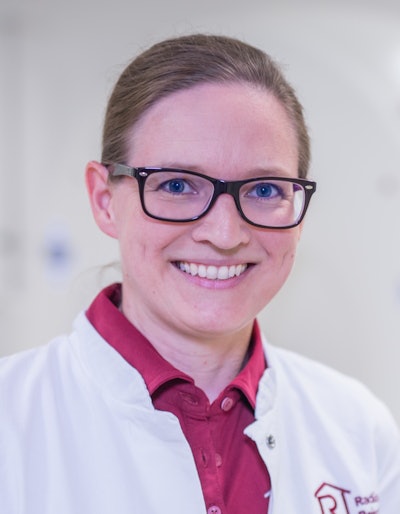
In Germany, many radiologists question whether they should stay employed or start their own practice. This dilemma has prompted Prof. Dr. Nina Schwenzer and Dr. Ulrike Engelmayer, respectively from the Bavarian towns of Ebersberg and Schwabmünchen, to create "Successfully starting your own practice -- a guide to self-employment in radiology."
The guide, which was a collaboration with the Forum of Radiologists in Private Practice (FuNRad) of the German Röntgen Society (Deutsche Röntgengesellschaft, DRG) and the Professional Association of German Radiologists, can serve as a decision-making aid. In this Q&A interview, Schwenzer and Engelmayer discuss how they became self-employed and describe their own journeys in more detail.
Q: What motivated both of you to switch from working in hospital radiology departments to private practice?
 Prof. Dr. Nina Schwenzer. Image courtesy of Andreas Thierschmidt.
Prof. Dr. Nina Schwenzer. Image courtesy of Andreas Thierschmidt.Schwenzer: What attracted me to set up our local center were the creative possibilities and the short decision-making processes, as well as the flatter hierarchies. But of course, I wouldn't want to miss the experience of working at a maximum-care hospital. It makes you more relaxed, especially in emergencies, because you've seen a lot of things before.
Engelmayer: I attach great importance to actively shaping my working environment, which was only possible to a limited extent in the hospitals where I was employed due to the hierarchical structures and the business requirements. Employee leadership is also very important to me because as a supervisor, I want to enable my employees to develop optimally in their workplace and to contribute their gifts and abilities to the company in a creative and self-determined way.
Q: Where did the idea for the guide come from?
 Dr. Ulrike Engelmayer.
Dr. Ulrike Engelmayer.Engelmayer: In my case, it took almost seven years before I was able to realize my dream of joining a radiology practice as a partner. In these seven years, I have had many positive and also negative experiences, which I wanted to pass on to others in the form of a guide. We need courageous colleagues in outpatient radiology who dare to take the plunge into self-employment. The guide is intended to provide orientation for these colleagues.
Schwenzer: Setting up your own practice is not a quick decision that you make overnight but a process. It is very time-consuming to get all the information, and with the guide we aim to shorten this research for individuals.
To what extent does working as a radiologist in a hospital differ from working in an outpatient setting?
Schwenzer: Basically, the work processes do not differ significantly. However, questions from the field of musculoskeletal radiology and neuroradiology are dominant, especially for MRI. The number of cases to be processed during the day is often higher, but there are fewer case conferences and tumor boards.
Weekend and night services are often eliminated. Image-guided interventions are often limited to arthrographies or other procedures that can be performed quickly -- unless the practice provides full service to a larger hospital.
Engelmayer: The work in the outpatient area is very diverse and heterogeneous and depends strongly on the practice structure in which the work takes place. Although there are limitations, there is more room for negotiation in terms of working time models and earning potential.
Q: What needs to be considered in terms of contracts and financing?
Schwenzer: At this point in the startup process, it is important to have at least one or two advisors at your side. This could be a tax advisor, for example, or a lawyer -- preferably from the field of medical law. There are many things to consider here, from financing and economic advice to the contractual regulation. Negotiations on the purchase price should also be conducted with support, since in many cases the value appraisals already available from the selling party must be critically examined.
Q: Can you describe the necessary formalities for starting a practice in more detail?
Schwenzer: Permits to perform CT, MRI, and sonography, for example, must be applied for individually and each requires certificates of qualification. Then one must pay attention to the change of status from employee to freelancer; this applies especially to the tax office and the medical pension fund. As a rule, one is also responsible for radiation protection and must notify the trade supervisory office accordingly.
Q: In the guide, you also address challenges and pitfalls when starting your own practice. What are these?
Schwenzer: It can be difficult if you don't understand the interrelationships, for example, in the case of special business assets, or if certain privileges have developed among the partners. Such circumstances must be explained in detail. As a matter of principle, one should never sign anything that one has not understood, or if the development loan is not yet "in the bag."
Engelmayer: There are challenges that we have experienced on the path to self-employment in general. One such challenge is the increasing commercialization of healthcare, also in the outpatient sector, due to the growing influence of financial investors. Secondly, in the outpatient sector, as in the inpatient sector, a change in values is taking place between the different generations of physicians, affecting personal issues such as life goals, status, and earnings, as well as business management.
Moreover, it is no coincidence that we two women in particular initiated the "Guide to Starting a Practice." After all, we female radiologists are still in the minority among radiologists in private practice, which also represents a challenge on the path to establishment.
Q: How do the Professional Association of German Radiologists and the DRG support radiologists on their path to establishment?
Engelmayer: To be honest, we both have to admit that we have hardly sought or received any support from the DRG or the Professional Association (BDR) on our way to branching out. This is also the reason for our motivation to take up this topic within the framework of our board activities in FuNRad and in the BDR.
Networks are being set up in which colleagues willing to establish a practice are advised and accompanied by experienced colleagues on the individual steps of starting a practice. We are also establishing a system in which sample contracts and other information can be made available. And we organize training courses and other events where people can exchange ideas and network. The more colleagues are involved in these networks, the stronger we become as a radiological community -- also in the outpatient sector.
Q: Is your guide also of interest to physicians in other specialist groups who want to enter the outpatient care sector?
Engelmayer: Apart from the first part of the guide, in which we compare the activity in outpatient radiology with the activity in inpatient radiology, all other parts contain information that is basically interesting and relevant for entry into practice. We would be very pleased if the guide is also useful to colleagues from other specialties and can support them on their own path.
You can read the guide as an ePaper in German. You can also find more information about the publication on the website of the Forum Niedergelassener Radiologen (FuNRad). Outpatient practice and radiology was also discussed at the 103rd German Congress of Radiology in Wiesbaden (25-27 May 2022). Sessions covered entry into practice, sustainability, and the prospects for outpatient radiology after the pandemic.
Editor's note: This is an edited version of a translation of an article published in German online by the DRG. Translation by Frances Rylands-Monk. To read the original, extended version, go to the DRG website.



















